As all of us experienced gardeners know, very few perennials are completely maintenance free. That beings said, some require less work than others and there is a wide selection that fall into the low maintenance category. Luckily for us, most of which thrive in the Willamette Valley. Many times the lower maintenance perennials are also drought tolerant and/or edible (herbs).
Regardless of a catchy label, all perennials require effort. For the most part, these low maintenance perennials require cutting back the flower stalks after the blooms have faded (however, some can be left standing into winter months to provide seeds for birds). Along with deadheading, occasional grooming may also be required. Some perennial plants will spread as they become established, so with time plants may need to be divided. Another good tip: you can create healthy plants by feeding and enrich the soil with a compost containing manure. As the garden becomes established, this process of composting can be done every one to two years. It is easiest to do after the plants have been cut down in the fall, but before they start growing in the spring.
Without further ado, here we present a list of plants as a starting point for anyone looking to update their landscape. As you research and shop for plant material, you are likely to find additional perennials that require little care. When making your selections, be aware that some varieties may reseed easily, spread quickly or require staking if they are a taller variety. It is important to read the labels carefully, ask questions with the store’s gardening expert and choose the plant that works best in your space.
The plant options in this list often come in a variety of color and/or sizes.

Achillea (Yarrow)
Yarrows love the sun and bloom from summer into fall. Their aromatic leaves range in color from green to grey. These plants are drought tolerant once established. Be watchful as Yarrow is known to become crowded and require dividing.

Agastache (Hyssop)
There are a wide variety of Agastaches on the market, each with their own unique style. Bloom colors can include pink, red, orange, purple and blue! Be sure to deadhead to encourage more blooming. Agastache grow best in full sun to part shade.
Artemisia
Several species of Artemisia are available locally. Their fragrant gray foliage adds texture and contrast to the landscape. These plants thrive in the full sun and can survive on little water once they are fully established. Remember to cut back in the fall to encourage new growth as older plants can become leggy and woody.
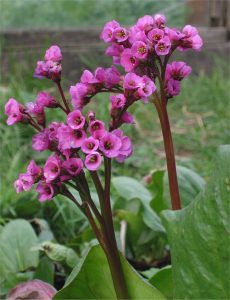
Bergenia (Elephant Ears)
Bergenias grow best in full/partial shade. They are a low grower, with large glossy green leaves that are often evergreen. Their foliage can show tints of red. Most types bloom in the spring and colors include white, pink or red. These are a great plant to add texture to any garden.
Echinacea (Cone Flower)
These tried-and-true plants do best in full sun with regular water. Flowers are visible for most of the summer and traditional blooms are either purple or white. However, plant developers have created new color varieties in shades of yellow and orange, increasing your options. Flower stalks can reach 4’ in height, but usually don’t require any staking. Attract finches to your garden by leaving the dried flower stalks and seed heads standing in winter months. These seed heads also add winter interest to your garden.
Euphorbia (Spruge)
Beware of Varieties that Spread and/or Seed
There is a wide variety of Euphorbias available; near 2,000 at last count if you include Poinsettias! Euphorbias can be very short ground covers or grow as high as 3-4’ tall. Sun exposure and watering needs will vary for each type, so be sure you know how to handle which ever Euphorbia you end up using. Most for sale in the Willamette Valley can get by with moderate watering and do well in full sun. They are an interesting textural plant and their tiny flower is set in a “cup” (cyathium). These flower “cups” can range in color from yellow to chartreuse with the foliage ranging anywhere from grey to burgundy. Do your research carefully, as some varieties seed prolifically or spread quickly. CAUTION: when cut or damaged, many Euphorbias produce a milky sap that is irritating and sometimes even poisonous.
Erysimum (Wall Flower)
Erysimum can handle full sun or light shade. Water needs vary by type, but are often drought tolerant once established. Flower clusters show themselves in late spring to early summer. Make sure to deadhead to encourage a second bloom. Typical foliage is grey-green, however some varieties are variegated and a variety of bloom colors are available.
Helleborus (Lenten Rose)
Helleborus are a fantastic shade plant, some varieties of which can handle somewhat sunnier locations. Most, if not all, don’t prefer direct, late afternoon sun. Depending on the variety, they will require moderate to heavy watering. Most bloom in the spring with flower colors including shades of pink, burgundy or white. Some blooms will include spots or freckles of other colors, such as white petals with burgundy highlights.
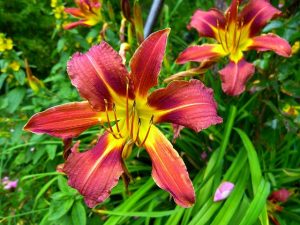
Hemerocallis (Daylily)
Daylilies grow in sun to part shade and need regular watering. These fleshy tubers produce blades of foliage with flower stalks that rise above the grassy fronds. Flower colors vary including shades of orange, pink, red and cream. These plants are tougher than they look and can handle a wide variety of conditions.
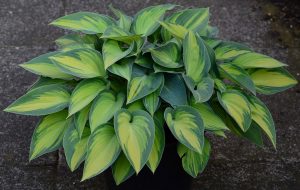 Hosta
Hosta
Shade loving Hostas thrive in rich, moist soils. While their leaves die back to the ground in the winter, during the summer their foliage creates lush texture in the landscape. Depending on the variety, plant size and leaf color can vary dramatically. Plant clumps can range in size from less than one to more than 5 feet across! Leaf color can be blue/grey, green, or variegated (green and white). During summer they produce spikes of white or blue/lavender flowers.
Iberis (Candytuft)
Iberis sempervirens is the variety of Candytuft that you typically see in our area. It is an evergreen groundcover that can reach 1 ½’ tall. In the spring it puts on a show of brilliant white flowers. It does best with regular watering in a sunny location. Other varieties of Iberis include annual, dwarf and autumn blooming varieties.
 Iris
Iris
There is an Iris for almost any garden situation! With over 200 options to choose from, you are sure to find the perfect one for your space. Their grass-like foliage grows from a bulb or rhizome. Flower stalks are topped by interesting and colorful blooms. There are a variety of different Iris’ including Bearded, Japanese, Dutch and Flag. Sun exposure and water needs will vary depending on the species selected.

Lavandula (Lavender)
Known for its fragrance, this small evergreen loves the sun! Lavender requires low to moderate watering and prefers well drained soil. The summer blooms of some varieties are used in perfumes, soaps, aromatic oils and food and beverages. Flower color options include white and shades of purple. Pollinators are attracted to most varieties and with their symbiotic relationship can help each other thrive.
Paeonia (Peony)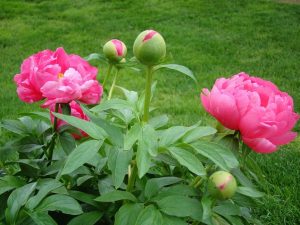
Peonies are long lived and well worth the investment. These spring bloomers inject a blast of color into your landscape. Size and bloom color varies dramatically throughout the species. They require regular watering and dislike hot afternoon sun. Their foliage can also turn vibrant colors in the cooler fall months. In many areas they are also deer resistant! Plants often require staking to help support the weight of the flowers. Keep on the lookout for ants, as these produce nectar that they love!
Perovskia (Russian Sage)
This fragrant, shrubby perennial requires little to moderate water once established. Russian Sage likes it hot and does best in full sun. Perovskia foliage is grey-green and soft and velvety to the touch and can reach 4’ in height. In summer, small spikes of lavender flowers emerge from the ends of the woody stems. Trim off spent flowers and remove any underground runners.
 Rosmarinus (Rosemary)
Rosmarinus (Rosemary)
This herbaceous evergreen shrub thrives in the full sun. Make sure that they are planted in an area with good drainage, and once established it can survive on little water. There are many types of Rosemary; some tall and shrubby, while other are low growing and cascade over walls. Known around the world for its aroma, its fragrant foliage will quickly make you think of your favorite Italian or Mediterranean recipe.
Rudbeckia (Black–Eyed Susan)
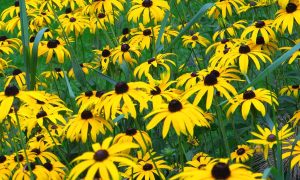 One of the most popular perennials, Black Eyed Susan’s sunny yellow/orange flowers brighten up the garden from summer into fall. When the flowers fade, their central cone remains and can be left standing into the winter months to provide winter interest and seed for the birds. Rudbeckias are sun lovers and are drought tolerant once established.
One of the most popular perennials, Black Eyed Susan’s sunny yellow/orange flowers brighten up the garden from summer into fall. When the flowers fade, their central cone remains and can be left standing into the winter months to provide winter interest and seed for the birds. Rudbeckias are sun lovers and are drought tolerant once established.

Salvia (Sage)
Known best for as a culinary herb, sage almost thrives on neglect. There are a wide variety of Salvias to choose from; a majority of which have fragrant foliage, love the sun and require some watering. This species can be an evergreen shrub or an annual (and just about every option in between). Size and flower color vary dramatically depending on the variety. Their flowers are another that attract pollinators to your garden.
Sedum (Stonecrop) short varieties

Most Sedums need little to moderate water and grow in full sun. They have fleshy evergreen leaves that store water and their height can range from a few inches up to a few feet tall. They are a perfect example to add a good element of texture to the landscape. Some varieties produce flowers and, color options include white, yellow, pink or red.
Did we miss any of your favorite low maintenance perennials? Let us know in the comments below!
